| Article ID | Journal | Published Year | Pages | File Type |
|---|---|---|---|---|
| 2590213 | NeuroToxicology | 2008 | 6 Pages |
It has been known for decades that methylmercury is a potent neurotoxicant, and that the developing brain is more susceptible to impairment as a result of methylmercury exposure than is the adult. Exposure to methylmercury is exclusively through consumption of fish and marine mammals. In recent years, the potential for protection against methylmercury toxicity by nutrients present in fish, particularly omega-3 fatty acids and selenium, has been explored in both epidemiological and experimental studies. There is evidence from several studies that fish consumption per se and methylmercury body burden act in opposition with regard to neuropsychological outcomes, whereas the evidence for a protective effect of specific nutrients is contradictory in both epidemiological and experimental studies published to date. The potential for methylmercury to interact with other chemicals present in marine food, particularly PCBs, has been explored in both animal models and human studies. Results may be both exposure- and endpoint-dependent. The Seychelles Islands study has explored the potential for the social environment to modify the effects of developmental methylmercury exposure. An understanding of the interactions of the multiple factors that determine the final behavioral outcome of exposure to methylmercury is crucial to risk assessment and risk management decisions.
